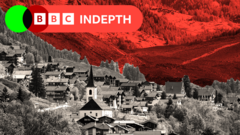In a picturesque valley of Switzerland lies Blatten, a village once home to a close-knit community of 300 residents, but now buried under a mass of rock, mud, and ice due to a catastrophic landslide. This disaster, triggered by the collapse of a glacier and subsequent instability of the mountain, forced the evacuation of residents just days prior. As locals grapple with the emotional and physical loss of their homes, the broader implications of climate change on Alpine communities come into sharp focus.
Matthias Bellwald, the mayor of a neighboring village, oversees the clean-up and reconstruction efforts while reflecting on the steep costs to restore Blatten, projected to run into hundreds of millions of dollars. With contributions pouring in from the public and promises of government support, the question lingers: is it worth the investment? The need for protective infrastructure has become critical as climate scientists warn of the increasing likelihood of such disasters as glaciers and permafrost thaw due to rising global temperatures.
The cultural significance of these Alpine villages is immense, yet some Swiss citizens question the sustainability of investing in villages threatened by natural disasters. The Alps are integral to the nation’s identity; each valley holds its own unique traditions that risk fading away amidst the dangers posed by climate change. Many residents remember the days when stability was taken for granted, now transformed into a fearful reality.
Recent studies indicate that changing climate conditions are altering the frequency and nature of landslides, raising alarms across Switzerland's mountainous landscape. The village of Brienz remains evacuated, with ongoing concerns over geological instability, while other villages like Kandersteg and Bondo confront similar threats. An editorial in a leading newspaper raised eyebrows by suggesting that at-risk communities might need to consider relocation as a viable long-term solution.
For many Swiss, the term "heimat" - meaning homeland - resonates deeply, often linked to cherished childhood memories and landscapes. As these communities face the reality of changing environments, the urgent need for preservation clashes with economic feasibility. Some fear the loss of cultural heritage akin to areas in northern Italy, where entire villages now stand abandoned.
With pressure on infrastructure and the need for adaptability, experts like Boris Previsic emphasize the importance of readiness for possible relocations while also fighting to keep communities intact. The sentiment among the locals remains unwavering; they treasure the mountains that have shaped their history, even if they pose ongoing risks. Daily, cleanup operations continue amidst a spirit of resilience as the victims of the Blatten disaster strive not just to rebuild but also to preserve the essence of their culture and identity in the face of climate change.


















